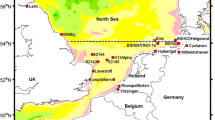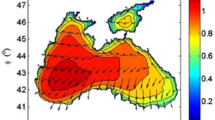Abstract
The effects of waves on Surface Drag Coefficient (SDC) and surface mixing length were analyzed and discussed by carrying out three-dimensional current modeling for the Bohai Sea in the present work. A three-dimensional coupled hydrodynamical-ecological model for regional and shelf seas (COHERENS) incorporating the influences of wave-current interactions was coupled with the third-generation wave model swan taking into account time-varying currents. The effects of waves on currents were included in the SDC, surface mixing length and bottom drag coefficient. Firstly, the formulations in Donelan were incorporated into the COHERENS to account for wave-dependent SDC. In order to compare simulation results for the wave-dependent SDC, the simulation for wind-dependent SDC was also carried out. Second, Wave-Induced Surface Mixing Length (described as WISML sometimes in this paper) was incorporated into the COHERENS. Four numerical experiments were conducted to discuss the effects of two kinds of wave processes. Generally, the values of time series of current velocity and water surface elevation given by the simulation with all of the three wave processes have a good agreement with observed data. The existence of WISML changes obviously current vertical profiles and the existence of the wave dependent SDC modifies the current field of both top and bottom layers with the wind-dependent SDC.
Similar content being viewed by others
References
LIN Xiang, YIN Bao-shu, HOU Yi-jun et al. The effects of radiation stress on wave heights and sea level in the interaction of coupled wave-tide-surge in the coastal area[J]. Journal of Hydrodynamics, Ser.B, 2003, 15(1): 97–102
YIN Bao-su, YANG De-zhou, LIN Xiang et al. Effects of wave-current interactions on bottom stress and currents[J]. Journal of Hydrodynamics, Ser.B, 2003, 15(5): 13–19.
ZHANG M.Y. and LI Y. S. The dynamic coupling of a third-generation wave model and a 3D hydrodynamic model through boundary layers[J]. Continental Shelf Research, 1997, 17(10): 1141–1170.
LIAN X., WU K. et al. A numerical study of wave-current interaction through surface and bottom stresses: Wind-driven circulation in the South Atlantic Bight under uniform winds[J]. Journal of Geophysical Research, 2001, 106(C8): 16841–16855.
DONELAN M. A., DOBSON F. W., SMITH S. D. et al. On the dependence of sea surface roughness on wave development[J]. Journal of physical Oceanography, 1993, 23(9): 2143–2149.
LUTYEN P. J., JONES J. E., PROCTOR R. A numerical study of the long-and short-term temperature variability and thermal circulation in the North Sea [J]. Journal of physical Oceanography, 2002, 33(1): 37–56.
HIRSCH C. Numerical computation of internal and external flows, Volume 2: Computational methods for inviscid and viscous flows[M]. New York: Wiley, 1990.
SCHREFLER B. Y., ZIENKIEWICZ O. C. Computer modelling in ocean engineering[M]. Rotterdam, The Netherlands: A. A. Balkema, 1988, 231–234.
LARGE W. G. and POND S. Open ocean momentum flux measurements in moderate to strong winds[J]. Journal of Physical Oceanography, 1981, 11(3): 324–336.
MELLOR G. L., BLUMBERG A. F. Wave breaking and ocean surface layer thermal response[J]. Journal of Physical Oceanography, 2003, 34(3): 693–698.
CRAIG P. D. and BANNER M. L. Simulating the wave-enhanced layer under breaking surface waves with two-equation turbulence models[J]. Journal of Physical Oceanography, 1994, 31(11): 3133–3145.
XING J. and DAVIES A. M. Application of turbulence energy models to the computation of tidal currents and mixing intensities in shelf edge regions[J]. Journal of Physical Oceanography, 1996, 26(4): 417–447.
DAVIES A. M. and LAWRENCE J. Examining the influence of wind and wind wave turbulence on tidal currents, using a three-dimensional hydrodynamic model including wave-current interaction[J]. Journal of Physical Oceanography, 1994, 24(12): 2441–2460.
DAVIES A. M. and LAWRENCE J. Modeling the effect of wave-current interaction on the three-dimensional wind-driven circulation of the eastern Irish Sea[J]. Journal of Physical Oceanography, 1995, 25(1): 29–45.
SIGNELL R. P., BEARDSLEY R. C., GRABER H. C. et al. Effect of wave-current interaction on wind-driven circulation in narrow, shallow embayments[J]. Journal of Geophysical Research, 1990, 95(6): 9671–9678.
Author information
Authors and Affiliations
Corresponding author
Additional information
Project supported by 973 Project (Grant No: 2002CB412408) and the Natural Science Foundation of Qingdao (Grant No: 03-jr-15).
Biography: LIANG Bing-chen, (1976-), Male, Ph. D., Lecturer
Rights and permissions
About this article
Cite this article
Liang, Bc., Li, Hj. & Lee, Dy. Numerical Study of Wave Effects on Surface Wind Stress and Surface Mixing Length by Three-Dimensional Circulation Modeling. J Hydrodyn 18, 397–404 (2006). https://doi.org/10.1016/S1001-6058(06)60111-X
Received:
Published:
Issue Date:
DOI: https://doi.org/10.1016/S1001-6058(06)60111-X




